Frogs That Eat Their Own Fertilized Eggs Then Throw Up the Babies That Hatch in Their Stomachs
What's in the Story?
Scientists searched for the fanged frog in the forests of the Sulwesi island in Indonesia. Image by Ariefrahman.
You lot're in the thick forests of Indonesia and there are no villages or people around for miles. Mosquitos buzz effectually your face as yous work your way through deep mud and dumbo bushes. Exhausted from the long, hot journey, you pause, but and so continue on your mission. Y'all're searching to find something that no one has ever seen earlier. Is it a treasure breast? The fountain of youth? Or the remains of an ancient civilization? Just and so, you hear it right in forepart of yous. "Ribbit, ribbit." Believe information technology or not, your impressive finding is a frog.
Scientists have been studying the life cycles of frogs for a long time. The more than research scientists conduct, the more we learn most the different means that frogs develop. In the PLOS 1 commodity "A Novel Reproductive Fashion in Frogs: A New Species of Fanged Frog with Internal Fertilization and Birth of Tadpoles," scientists investigated a new way that frogs reproduce.
Hatching isn't for Anybody
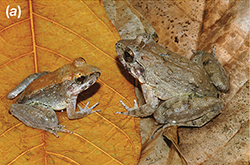
A male (left) and female person (right) fanged frog sit down on a large leaf. Click to enlarge.
Typically, frogs lay eggs. This process usually occurs through external fertilization, where the female releases her eggs from her torso into water. And then, the male releases his sperm to fertilize them.
All the same, a few species of frog use internal fertilization. In this instance, the eggs are fertilized inside the female'southward body before they are released. All mammals, including humans, utilise this procedure of fertilization.
For many years now, scientists have known near a species of fanged frog, Limnonectes larvaepartus, found in the forests of Sulawesi (an Indonesian island). Still, little was known about how this species reproduced.
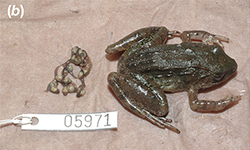
Inside of the female fanged frog, the researchers constitute developed tadpoles rather than eggs. Click to overstate.
Was information technology through the more mutual process of external fertilization? Or internal fertilization? Do they lay eggs on leaves or in h2o, like most frog species?
In a recent trek to Indonesia, scientists went out to explore streams and other bodies of water. They searched for these fanged frogs, and caught them with their hands. After catching a number of these frogs, they discovered something unexpected.
Instead of eggs, they found tadpoles inside the frogs. The scientists first noticed this while dissecting, or cutting into, the bodies of dead frogs. They did this to improve understand the internal structure of the frogs.
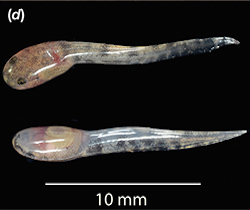
A shut-up view of the tadpoles found within a female fanged frog. Click to enlarge.
The scientists also wanted to study the body tissue and Dna from the frogs to map the frogs' genes. This would aid scientists to learn the relationship between this frog species and others.
In the bodies of some female frogs, scientists found fully developed tadpoles. In one case, a meaning female gave nascence to live tadpoles on the hand of a researcher who caught her.
These tiny tadpoles were mostly clear in color with spots around their bodies. This finding is very unusual considering scientists simply expected to observe eggs, which are mutual in most female person frogs.
A Ane of a Kind Frog
Why does this divergence make the fanged frog so special? Well, there are over 6,000 known species of frogs, and this is but i that scientists know of that gives birth to live tadpoles.
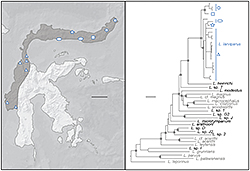
Scientists used a map of Indonesia to evidence the locations of the fanged frogs they found, and how these related to other like frog species. Click for more than detail.
The simply frogs that give nascence in a similar way come from 2 African toad genera, Nectophrynoides and Nimbaphrynoides, and a now extinct species, Eleutherodactylus jasperi. These species requite birth to miniature frogs, called froglets, rather than tadpoles. This makes the reproductive process for the fanged frog unique to any other frog that scientists currently know nigh.
Scientists discovered that the fanged frog uses internal fertilization. Though internal fertilization is found in other frogs, the other species either lay eggs or requite birth to froglets. Discoveries like this are very exciting because it opens a whole new door of possibilities for how frogs reproduce. It also brings up questions virtually the larger function they have in the ecosystem because of their unique life history.
The Secret Life of Fanged Frogs
For the few frog species that use internal fertilization, the males use an intromittent organ. This is a tail-like construction located at the end of their bodies that they use to transfer sperm into the female.
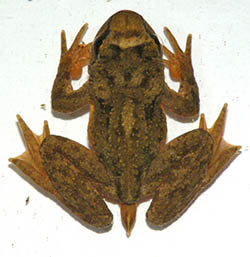
In general, the intromittent organ allows a male to evangelize sperm to the female person during internal fertilization. Scientists were puzzled that the male fanged frog did non announced to have this organ. Prototype by Mokele.
However, such an organ has not been establish in male fanged frogs. This has left scientists puzzled as to how the eggs are fertilized. Unfortunately, no one has seen this fanged frog mate in the wild.
Then, how practise we know that these frogs use internal fertilization? Simply put, since the scientists saw the frog give nascence to live tadpoles, fertilization must have occurred within the frog's torso. Fertilization would need to take occurred so that the tadpoles could develop inside the female frog's body in the first identify.
In that location is still much to be learned from the fanged frog, such as how females know when to requite nascence. But then over again, at that place remains much more to be discovered in this foreign, bizarre, and amazing earth of ours.
Click here to learn more about this new species of fanged frog.
Additional Images via Wikimedia Commons. Image of ii tadpoles past Tarquin.
Source: https://askabiologist.asu.edu/plosable/tadpole-or-egg
0 Response to "Frogs That Eat Their Own Fertilized Eggs Then Throw Up the Babies That Hatch in Their Stomachs"
Post a Comment